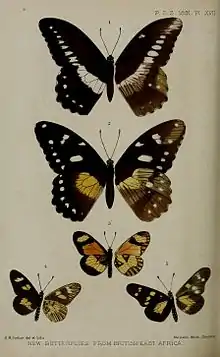| Acraea oreas | |
|---|---|
 | |
| Figure 5 | |
| Scientific classification | |
| Domain: | Eukaryota |
| Kingdom: | Animalia |
| Phylum: | Arthropoda |
| Class: | Insecta |
| Order: | Lepidoptera |
| Family: | Nymphalidae |
| Genus: | Acraea |
| Species: | A. oreas |
| Binomial name | |
| Acraea oreas | |
| Synonyms | |
| |
Acraea oreas, the black-and-white acraea, is a butterfly in the family Nymphalidae. It is found in Nigeria, Cameroon, Angola, the Democratic Republic of the Congo, Sudan, Uganda, Rwanda, Burundi, Kenya, Tanzania and Zambia.[3]
Description
A. oreas E. Sharpe (57 c). Both wings deep black above, with yellow markings; the forewing spotted quite as in [forma] fallax and confusa, but in addition with a similar spot in the cell; the hindwing with a long but narrow median area, which covers the cell and the base of cellules 2-7, but is proximally bounded by vein 2, thus not nearly reaching the inner margin; the fore wing is somewhat longer and narrower than in johnstoni and lycoa. On the under surface the hindwing and the apical part of the forewing have a rust-brown ground colour with black longitudinal streaks; the light markings almost as above, but the yellow median area of the hindwing emits a branch to or almost to the middle of the inner margin. Angola; German and British East Africa; Uganda, ab. albimaculata Neave. Spots of the forewing white. In the same localities as the type-form. f. angolana Lathy.[ now subspecies ] Marginal band of the hindwing beneath and apical part of the forewing with grey-yellow ground-colour; spots of the forewing white. Angola. female-ab. radians ab. nov. (= angolana female-ab. Lathy) only differs from angolana in the yellow median area of the hindwing above extending in broad rays between the veins nearly to the distal margin; the spots on the upperside of the forewing yellowish. Angola. [4]
Subspecies
- Acraea oreas oreas (Democratic Republic of the Congo: Ituri and northern Kivu, southern Sudan, Uganda, Rwanda, Burundi, Kenya, northern and western Tanzania)
- Acraea oreas angolanus Lathy, 1906 (Angola, Democratic Republic of the Congo: Shaba, northern Zambia)
- Acraea oreas oboti Collins & Larsen, 2000 (Nigeria: Obudu Plateau and Mambilla Plateau, Cameroon)
Biology
The habitat consists of mountainous areas at altitudes between 1,300 and 2,000 metres.
Adults are attracted to damp patches, excrement and rotten meat.
The larvae feed on Urera cordifolia and Morus species.
Taxonomy
It is a member of the Acraea circeis species group- but see also Pierre & Bernaud, 2014 [5]
References
- ↑ Sharpe, E.M. 1891a. Descriptions of new butterflies collected by Mr. F.J. Jackson, F.Z.S., in British East Africa, during his recent expedition. Part I. Proceedings of the Zoological Society of London 1891: 187-194.
- ↑ "Acraea Fabricius, 1807" at Markku Savela's Lepidoptera and Some Other Life Forms
- ↑ "Afrotropical Butterflies: Nymphalidae - Tribe Acraeini". Archived from the original on 2012-08-10. Retrieved 2012-06-05.
- ↑ Aurivillius, [P.O.]C. 1908-1924. In: Seitz, A. Die Grosschmetterlinge der Erde Band 13: Abt. 2, Die exotischen Grosschmetterlinge, Die afrikanischen Tagfalter, 1925, 613 Seiten, 80 Tafeln (The Macrolepidoptera of the World 13).Alfred Kernen Verlag, Stuttgart.
 This article incorporates text from this source, which is in the public domain.
This article incorporates text from this source, which is in the public domain. - ↑ Pierre & Bernau, 2014 Classification et Liste Synonymique des Taxons du Genre Acraea pdf
External links
- Die Gross-Schmetterlinge der Erde 13: Die Afrikanischen Tagfalter. Plate XIII 57 c
- Images representing Acraea oreas at Bold
- Images representing Acraea oreas oboti at Bold
- Acraea oreas oreas Archived 2020-01-27 at the Wayback Machine at Pteron